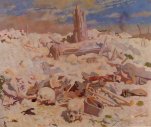
The Western Front: Belgium and Northern France
This timeline can be found in When the Barrage Lifts: Topographical History and Commentary on the Battle of the Somme, 1916 by Gerald Gliddon. The author used General Rawlinson's diary as a primary work. His work is an invaluable source of information and helps to understand the entire scope of the battle.
"mm" is the daily measurement of rainfall, and the two degree measurements represent the highest and lowest Fahrenheit temperature each day. "Trace" is a reference to minimal rainfall.
| Friday, June 23rd | Rain 2mm. Temperature 79° - 55° windy. |
| Saturday, June 24th | Rain 1mm. 72° - 52° overcast. Bombardment begins that lasts for 7 days. |
| Sunday, June 25th | Rain 1mm. 71° - 54° windy. |
| Monday, June 26th | Rain 6mm. 72° - 52° cloudy. |
| Tuesday, June 27th | Rain 8mm. 68° - 54° overcast and cloudy. Aeroplane work interfered with. Haig visits Rawlinson, they observe from the Grandstand near Querrieu. |
| Wednesday, June 28th | Rain 2mm. 68° - 50° overcast. The rain was very heavy. Commencement of battle delayed until 1st July at 7.30 a.m., instead of the 29th of June. |
| Thursday, June 29th | Some rain. 66° - 52° cloudy - low clouds and strong winds all day. If battle had begun on this day then conditions under foot would have been very slippery. |
| Friday, June 30th | 72° - 48° overcast, and high wind, but conditions improved towards the evening. Rawlinson noted in his War Diary that the total number of men involved at the start of the battle were about 500,000, that there were 1,500 guns of which 450 were of a large calibre, 150,000 rounds were fired in the day and 50,000 in the night into the enemy front lines. |
 The sector of the Somme battlefield in which the actions of the Royal Berkshire battalions took place | |
| Saturday, July 1st | 79° - 52° clear sky. Very hazy but the mist lifted at 7.30 a.m. when the Allied attack began. The offensive was a combined Franco-British one on a 25-mile front both north and south of the Somme. The British captured Montauban and Mametz. The French attacked towards Peronne and reached the outskirts of Hardecourt and Curlu. To the north-west of the Albert-Bapaume road the British made little progress against the German defences except for a small gain at the Leipzig Redoubt to the south of Thiepval. They had failed at Gommecourt, Serre, Beaumont Hamel, Thiepval and la Boisselle. Casualties were in the vicinity of 57,000, the highest casualty figure that the British Army ever suffered. There were nine VC awards that stemmed from the day's fighting. |
|
|
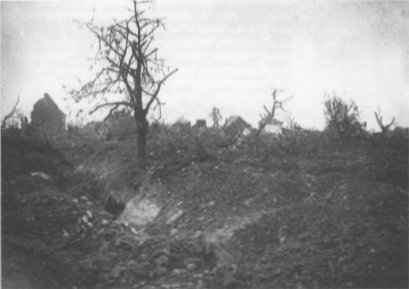 The site of Montauban village, July 1916 |
|
| Sunday, July 2nd | 75° - 54° clear sky, fine. Fricourt is surrendered by the Germans. Good deal of cloud in the morning. Rawlinson's estimate of casualties was 30,000. He was visited by Haig and Kiggell. Robertson lunched with him. |
| Monday, July 3rd | Rain 2mm. 68° - 55° thunderstorms to the south-east. Fine day with some clouds. La Boisselle was captured and part of Ovillers. Thomas George Turrall won the VC at la Boisselle. |
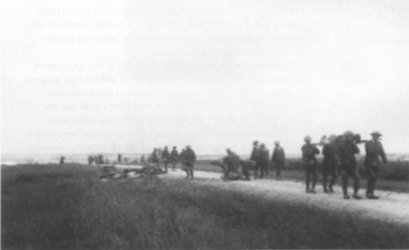 Bringing in wounded men on the Albert-Bapaume road near La Boisselle, July 3rd, 1916 | |
| Tuesday, July 4th | Rain 17mm. 70° - 55° overcast, thunderstorms, windy and cool air. La Boisselle taken, as well as Bernafay Wood. |
| Wednesday, July 5th | 72° - 52° low cloud until evening. Horseshoe Trench taken. D. S. Bell gained the VC there. T. O. L. Wilkinson and Adrian Carton de Wiart both gained the VC at la Boisselle. Many Germans were assembling in Mametz Wood. |
| Thursday, July 6th | Rain 2mm. 70° - 54° overcast and dull with showers at intervals. Attack on Trones Wood was delayed for 24 hours. Lloyd George was appointed Secretary of State for War and Lord Derby Under Secretary for War. |
| Friday, July 7th | Rain 13mm. 70° - 59° overcast and showery. Contalmaison captured as well as Leipzig Redoubt. Heavy rain in the evening and Contalmaison lost. The British failed to get into Mametz Wood. |
| Saturday, July 8th | Rain 8mm. 73° - 52° overcast. British penetrate Trones Wood. Haig visited Rawlinson. |
| Sunday, July 9th | 70° - 53° cloudy and fine. Large fire reported at Martinpuich and Station. Trones Wood fighting continues. E. S. Montagu appointed Minister of Munitions. |
| Monday, July 10th | 82° - 48° overcast, very hot, no wind, thick cloud bank. Heavy fighting in Trones Wood. Progress in the fight for Mametz Wood by the 38th Div. |
| Tuesday, July 11th | 68° - 52° overcast. Contalmaison was held against counter-attacks. Fighting all in Trones and Mametz Woods. |
| Wednesday, July 12th | Rain-trace. 68° - (?) fine but overcast. Mametz Wood totally captured, Contalmaison counter-attacks repulsed. Plans for dawn attacks on the 14th were finalised. |
| Thursday, July 13th | Rain-trace. 70° - 54° overcast, strong west wind and a little rain. End of the Battle of Albert which began on the 1st July. |
| Friday, July 14th | Fine but overcast. British attack the German second line beginning at 3.25 a m under very heavy bombardment. They captured Longueval and Bazentin le Petit and the whole of the Trones Wood where W. E. Boulter gained the VC. The Second Cavalry was sent in to the battle with High Wood as their objective. Haig and Foch came to see Rawlinson to congratulate him on the success of the dawn advance. |
| Saturday, July 15th | 72° - 47° misty in the morning which turned into a bright clear day. Beginning of the battle for Delville Wood. High Wood not captured. |
| Sunday, July 16th | Rain 4mm. 73° - 55° dull and overcast. The British consolidate their positions and withdraw from High Wood. |
| Monday, July 17th | 70° - 59° misty and overcast. Waterlot Farm taken to the east of Longueval, Ovillers completely cleared of Germans. Battle of Bazentin Ridge ends. |
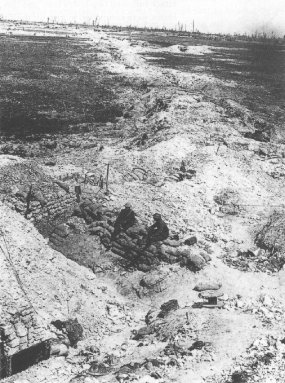 Old German trenches near Ovillers | |
| Tuesday, July 18th | 72° - 52° overcast. Attack on Fromelles to the north of the Somme battlefield. Germans make strong counter-attacks at Longueval and Delville Wood. W. F. Faulds gains the VC at the last named. Drizzling rain after a dull morning. |
| Wednesday, July 19th | 70° - 50° cloudy. Germans attack Longueval and fighting in Delville Wood continues. Attacks by the enemy; on Waterlot Farm and Trones Wood repulsed by the 35th Div. (Bantam). |
| Thursday, July 20th | 75° - 52° fine morning, clear skies. Longueval and Delville Wood fighting continues. J. J. Davies and A. Hill both awarded the VC for their role in the Delville Wood fighting and T. W. H. Veale also gained the VC to the east of High Wood. William la Touche Congreve is awarded the VC for actions between July 6th and the 20th. He loses his life to a sniper's bullet. |
| Friday, July 21st | 75° - 52° fine day with clear skies. Fighting at High Wood. Haig visits Rawlinson and impresses on him the need to capture the village of Guillemont. |
| Saturday, July 22nd | Rain-trace. 77° - 55° clear sky although dull early on. Violent fighting on the front Pozieres to Guillemont. New German trench line had been discovered from the air in front of the Switch Line to the north-west of High Wood. |
| Sunday, July 23rd | 68° - 54° overcast. The second phase of the Somme battle begins and this includes fierce fighting in and around the village of Pozieres. The British recapture the whole of Longueval but the Germans retake the northern part of the village. The outskirts of Guillemont changed hands twice. At Pozieres two men gained the VC. J. Leak and Sec. Lt. Blackburn. Rawlinson noted in his diary that the Germans had not relinquished their attacks in Verdun although they had skimmed their line in order to release troops for the Somme battle. |
| Monday, July 24th | 70° - 55° overcast and very hot. Fighting at Pozieres continues and the Germans counter-attack at High Wood and Guillemont. T. Cooke gained the VC at Pozieres in the dates July 24th/25th. |
| Tuesday, July 25th | 66° - 50° overcast. The current series of attacks against High Wood end. The Germans counter-attack in the Longueval and Bazentin areas. Pozieres is almost entirely in Allied hands and the British push along the Albert-Bapaume road. Rawlinson visited Fricourt which he described as a series of craters. |
| Wednesday, July 26th | 75° - 55° windy day. The whole of Pozieres village in Allied hands. |
| Thursday, July 27th | Rain 8mm. 81° - 61° hazy day that became a clearer afternoon. Further British attacks and gains in Delville Wood. Fighting continued near Pozieres and at Longueval. A. Gill won the VC at Delville Wood. |
| Friday, July 28th | 77° - 59° overcast and hot day. The British captured Longueval and Delville Wood and made further progress near Pozieres. Castleton gained the VC near Pozieres. Haig visited Rawlinson. |
| Saturday, July 29th | 81° - 57° overcast. German attempts to retake Delville Wood fail. Hand to hand fighting to the north and north-east of Pozieres. The Australians fail to take the Windmill near Pozieres and Munster Alley still in contention. |
| Sunday, July 30th | 82° - 57° clear day and very hot. The British make progress east of Waterlot Farm and Trones Wood. Large explosion at Martinpuich. G. Evans won the VC at Guillemont and J. Miller at Bazentin le Petit on the 30th/31st. The attack against Guillemont did not succeed. |
| Monday, July 31st | 82° - 59° very hot day and hazy in the morning. Fighting for Guillemont continued. RFC bombed Martinpuich. |
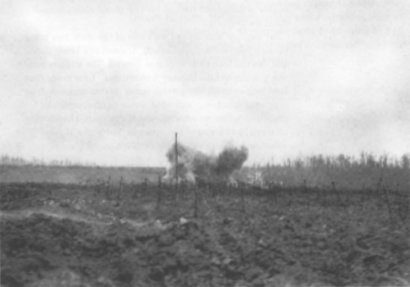 Shells bursting on British wire Bazentin le Grand, September 1916 | |
| Tuesday, August 1st | 86° - 61° very hot day. North of Bazentin le Petit the German counterattack was repulsed. Heavy fighting at Verdun. |
| Wednesday, August 2nd | 88° - 57°. German attack on Delville Wood repulsed. More heavy fighting at Verdun. Hottest day so far in the battle of the Somme. |
| Thursday, August 3rd | 84° - 57° hot and clear day. The British gained ground to the west of Pozieres and the French progressed at Verdun. An explosion at Courcelette caused smoke to rise 2,000 feet. In Britain Sir Roger Casement was hanged. |
| Friday, August 4th | 79° - 52°. The Allies gained the German Second Line system on a front of 2,000 yards to the north of Porieres. German counter-attacks at Verdun repulsed. |
| Saturday, August 5th | 68° - 48° clear day. The British advanced their line near Pozieres. Haig visits Rawlinson and is pleased at the Australian success near Pozieres, which included the taking of objectives and the capture of several hundred prisoners. |
| Sunday, August 6th | 75° - 52°. Slight Allied progress to the east of Pozieres towards Martinpuich. Private W. Short gained the VC at Munster Alley. |
| Monday, August 7th | 77° - 50°. The British attacked the outskirts of Guillemont. German attacks to the north and north-east of Pozieres repulsed. The French progress at Verdun. Kiggell wrote to Rawlinson and indicated that reports of British casualties had been exaggerated at home. |
| Tuesday, August 8th | 77° - 52°. British fighting at Guillemont continues. The Station was captured and the northern parts of the village, but not the southern end. G. G. Coury gained the VC near Arrow Head Copse. |
| Wednesday, August 9th | 84° - 53°. Renewed Allied attacks against Guillemont fail. Capt. N. C. Chavasse won the VC at Guillemont and Private O'Meara at Pozieres for work done in the period August 9th/12th. |
| Thursday, August 10th | Rain 4mm. 70° - 55° heavy rain and low clouds throughout the day. King George Vth visits the front and Rawlinson takes him to the craters at Bois Francais. The King tells Rawlinson of a Cabal at home that is out to oust Haig and curb the current offensive. The members of the Cabal include Lord French, Winston Chruchill and F. E. Smith. The British make progress to the north-west of Pozieres. |
| Friday, August 11th | 77° - 59° stormy day and misty in the morning. |
| Saturday, August 12th | Rain 1mm. 82° - 63°. The British advance on a mile front north-west of Pozieres. |
| Sunday, August 13th | 81° - 59° windy day. Munster Alley was taken by the 15th Division. |
| Monday, August 14th | Rain 2mm. 77° - 59° showery day. |
| Tuesday, August 15th | 75° - 57°. The King returned to England after his visit to the Western Front. At night it rains hard. |
| Wednesday, August 16th | Rain 2mm. 75° - 55°. The British advance west and south-west of Guillemont. Albert Ball took on five hostile aeroplanes in his Nieuport Scout. |
| Thursday, August 17th | Rain 4mm. 72° - 54° showery day with bright intervals. |
| Friday, August 18th | Rain 1mm. 70° - 55° overcast day. Ground gained by the British towards Ginchy and Guillemont. Enemy aircraft crashes near High Wood. 33rd Division fail to progress at High Wood. |
| Saturday, August 19th | Rain 2mm. 70° - 50° overcast day. British gain ground, in Thiepval Ridge area. |
| Sunday, August 20th | 72° - 54° overcast day. Germans counter-attack near Thiepval. |
| Monday, August 21st | 72° - 48°. Progress by the British north-west of Pozieres, Germans counter-attack near Thiepval. |
| Tuesday, August 22nd | 72° - 52°. Two determined counter-attacks by the Germans south of Thiepval were beaten off. Haig visits Rawlinson and chides him about Guillemont still not being in British hands. |
| Wednesday, August 23rd | 72° - 54°. Fighting continues to the south of Thiepval. Strong German attacks at Guillemont repulsed. Rawlinson hears that twelve tanks had arrived. |
| Thursday, August 24th | 78° - 55°. Further progress by the British towards Thiepval and the north-west part of Delville Wood. German attacks to the west of Ginchy driven off. |
| Friday, August 25th | Rain 8mm. 81° - 61° overcast and cloudy day. German attack south of Thiepval repulsed and the enemy driven out of Delville Wood and a line established along the north-east edge. |
| Saturday, August 26th | Rain 7mm. 75° - 59°. The Germans counter-attacked near Thiepval. Rawlinson saw the tanks in training and was impressed with them but thought that their crews needed much more training for battle conditions. |
| Sunday, August 27th | Rain 4mm. 73° - 59°. The Third Brigade attacks Grevillers. Italy declares war on Germany. |
| Monday, August 28th | Rain-slight. 73° - 59°. Because of the considerable rainfall of the previous few days the conditions were getting worse and some trenches were ankle deep in water. Kiggell visits Rawlinson and they discuss how best to use the tanks in battle. Rawlinson favours caution in their use. |
| Tuesday, August 29th | Rain-heavy, but no figures. 82° - 59°. Since the battle began on July 1st the British have captured 266 German Officers, 15,203 other ranks, 86 guns and 160 machine guns. Von Hindenburg appointed Chief of General Staff in place of Von Falkenhayn and Von Ludendorff Chief Quarter Master General. |
| Wednesday, August 30th | Rain 8mm. 67° - 48° overcast and very wet day. The trenches at Guillemont are very wet and muddy. |
| Thursday, August 31st | 70° - 72° fine day. Fierce German attacks between Ginchy and High Wood repulsed. First sight of the German aircraft called the Albatros which was to turn the Air War in Germany's favour. This aircraft had twice the fire power of a British fighter and fired synchronised machine guns between its propellor blades. Albert Ball shoots down two enemy aircraft. |
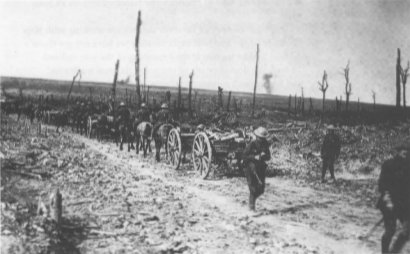 Delville Wood, September 1916 | |
| Friday, September 1st | 72° - 52°. German attacks at High Wood fail but they are back again in the eastern side of Delville Wood. |
| Saturday, September 2nd | 75° - 52° windy day. Rawlinson inspects the tanks again and is not pleased with their training and handling. |
| Sunday, September 3rd | Rain 4mm. 72° - 50°. The Battle for Delville Wood ended and also that of Pozieres Ridge. The Battle for Guillemont was won by the British, but Ginchy was first taken and then lost. Four VCs were gained on this day; one by W. B. Allen near Mesnil and three at Guillemont; J. V. Holland, T. Hughes and D. Jones. Continuous fighting towards Falfemont Farm and High Wood. |
| Monday, September 4th | Rain 25mm. 66° - 52° low clouds and showers all day. Another attack on Falfemont Farm fails. Haig has tea with Rawlinson and urges on him the necessity of pressing on and is pleased at the taking of Guillemont. |
| Tuesday, September 5th | 63° - 54° overcast and cloudy day. East of Guillemont the Allied line is carried forward 1,500 yards and most of Leuze Wood is captured. The Allies now occupied the whole of the German second line. During the night Falfemont Farm taken. |
| Wednesday, September 6th | 70° - 52° overcast. Guillemont consolidated and the British advance to Ginchy completed. Leuze Wood is secured. H. H. Asquith visits the front and inspects the ruins of Fricourt. He was accompanied by Maurice Hankey and Maurice Bonham-Carter. He lunches with Rawlinson. |
| Thursday, September 7th | 70° - 54° fine clear day with much aerial activity. |
| Friday, September 8th | 70° - 55° fine warm day but overcast, until 1 p.m. The Gloucester Regiment lost heavily in an attack to the west end of High Wood. |
| Saturday, September 9th | Rain 5mm. 75° - 57°. Ginchy falls to the British. Trenches also taken to the north and east of Leuze Wood. L. Clarke wins the VC near Pozieres. |
| Sunday, September 10th | Rain 1mm. 68° - 57° overcast day. The Germans counter-attacked at Ginchy but were repulsed. The British line to the east of Guillemont was advanced. Rawlinson attends a conference which features the role of the tanks in the forthcoming battle. |
| Monday, September 11th | Rain-trace. 66° - 54° overcast day. British artillery cause fires in German ammunition dump at Grandcourt. Rawlinson takes a break at Boulogne, to be ready for the September 15th attack. |
| Tuesday, September 12th | 72° - 55° fine but dull. The French take the area to the south of Combles as far as the river. Intense British preparatory bombardment. |
| Wednesday, September 13th | 72° - 52° dull and overcast day. The French progress to the southeast of Combles. |
| Thursday, September 14th | 61° - 41° windy day and cold. British storm trenches to the south-east of Thiepval and take the Wonderwork. Haig visits Rawlinson who is now back from Boulogne. He urges that Martinpuich should be attacked in earnest and that the Cavalry should be pushed out towards le Sars. |
| Friday, September 15th | 59° - 43°. This day was one of great progress for the Allies and the British began the third phase of the Battle of the Somme by advancing on a six mile front to a depth of 2,000 to 3,000 yards. Flers, Martinpuich, Courcelette and High Wood were all captured and tanks made their first ever appearance in battle. The French Army progressed to the south of Rancourt and captured a system of trenches north of the Priez Farm. There were three VCs awarded on this day; D. F. Brown gained his east of High Wood, J. V. Campbell at Ginchy and F. McNess close to Ginchy. During the days from September 15th to the 24th Manfred von Richthofen the future German ace shot down his first aircraft, and Albert Ball shot down four German aircraft in the same period. The day was cool with a morning mist and a slight ground haze. The main delay was that the Guards advancing towards Lesboeufs were held up by the Quadilateral German position. Rawlinson very pleased with the part played by the tanks in the advance. |
| Saturday, September 16th | 66° - 41° fine sunny day. The Germans counter-attacked at Courcelette but the British gained some territory. Danube Trench and Mouquet: Farm were taken by the Allies. J. C. Kerr gained the VC at Courcelette. The New Zealanders made progress to the north and west of Flers. |
| Sunday, September 17th | Rain 2mm. 63° - 45°. A comparatively quiet day, consolidation at Martinpuich by the 15th Division. Haig visits Rawlinson and congratulates him on the progress of 15th and 16th September. |
| Monday, September 18th | Rain 13mm. 63° - 46° continuous rain all day. The Sixth Division took the troublesome Quadrilateral between Ginchy and Bouleux Wood to a depth of a thousand yards. |
| Tuesday, September 19th | Rain 3mm. 55° - 43° wet and windy day which hinders operations. Trenchard takes tea with Rawlinson and tells him that 400 aircraft have been got through since July 1st, from reserves now exhausted. Kiggell reports Haig's views as being that battle should continue until either a shortage of troops or a decline in the weather prevents further fighting. |
| Wednesday, September 20th | Rain 1mm. 61° - 48° showery and unpleasant day. The Germans: suffer reversals at the hands of the French close to Combles. Rawlinson delays the next attack to the 23rd of the month. The wind and rain hampered the bringing up of munitions. Haig visits Rawlinson; it is agreed that the 1 Cavalry Division should be withdrawn. |
| Thursday, September 21st | Rain-trace. 59° - 48° cloudy and showery day. The New Zealanders have taken Cough Drop Alley and a good bit of the Flers Line, whilst the 1st Division captured Starfish Trench. Albert Ball destroys two more enemy aircraft. |
| Friday, September 22nd | 64° - 41° fine sunny day with a misty morning. The ground conditions were much improved as a result of a drying day. The British advance to the east of Courcelette. William Robertson has tea with Rawlinson and tells him that Lloyd George is concerned about the number of casualties and Haig's direction of the battle. Battle of Flers-Courcelette ends. |
| Saturday, September 23rd | 66° - 43° a fine warm day. The operations delayed until the 23rd have been put off until the 25th. A quiet day with the 23rd Division making some ground to the east of Martinpuich. |
| Sunday, September 24th | 72° - 45° a misty morning that turned into a very fine and warm Autumn day. Enemy attacked unsuccessfully to the west of Lesboeufs. |
| Monday, September 25th | 73° - 50° a cloudless day. A very successful day for the British; and Lesboeufs and Morval were both captured. The village of Combles was hemmed in by the Allies and the French had progressed at Rancourt, Les Priez Farm, and Fregicourt. The Battle of Morval began. T. Jones gained the VC at Morval. Rawlinson was very pleased with the Allied progress. |
| Tuesday, September 26th | Rain-trace. 75° - 54°. Fine day and another good one for the British advance. Combles fell to the Allies and Thiepval was at last captured. The Battle for Thiepval Ridge began. The British also stormed Guedecourt. R. E. Ryder and F. J. Edwards both gained the VC at Thiepval. |
| Wednesday, September 27th | Rain-trace. 72° - 52° overcast with some showers in the afternoon. The British attack Stuff Redoubt and advance to the north of Flers, to the east of Eaucourt L'Abbaye. T. E. Adlam was awarded the VC for his gallantry during the days the 27th/28th September and A. C. T.White for his at Stuff Redoubt in the period September 27th and October 1st. |
| Thursday, September 28th | Rain 1mm. 73° - 54° a fine warm day with some showers. The British attack the Schwaben Redoubt on the crest of the Thiepval Plateau, and capture most of it. They advance to the north and north-east of Courcelette, between Martinpuich and Guedecourt. The French make progress at Morval and the Battles of Morval Ridge end. Rawlinson inspects the ground conditions and describes them as appalling. The ground is so completely flattened that the extension of railways is made impossible. The whole ground is covered with troops, guns, lines and bivouacs. A German airman could not drop a brick without killing something he wrote. |
| Friday, September 29th | Rain 17mm. 61° - 54° a very wet and windy day. Very poor weather for flying observation and for the cor;condition of the roads. The British captured Destremont Farm which was a strongly defended group of buildings. |
| Saturday, September 30th | 63° - 41° fine day but overcast at times. The Thiepval Ridge was captured except for part of Schwaben Redoubt. Also an advance made at the south of Eaucourt L'Abbaye. |
| Sunday, October 1st | 63° - 41° a fine sunny day. The clocks were put back one hour at 1.00 a.m. The Battle of Transloy Ridge and Ancre Heights began. The British attacked on the line Eaucourt-le Sars (on the Albert-Bapaume Road) and captured all their objectives on a front of 3,000 yards. Eaucourt was occupied. R. B. Bradford gained the VC at Eaucourt L'Abbaye and Albert Ball drove down two enemy aircraft near Gommecourt. |
| Monday, October 2nd | Rain 3mm. 57° - 45° a wet and misty day. The airmen could not fly in the conditions. The Germans counter-attacked in Eaucourt and the British failed to hold le Sars. |
| Tuesday, October 3rd | Rain-trace. 70° - 50° rainy and misty day. The British recover Eaucourt L'Abbaye. In the afternoon Rawlinson made the first of two visits to local RFC Fighter Squadrons. |
| Wednesday, October 4th | Rain 4mm. 66° - 52° overcast with a very wet morning, finer in the afternoon. The next operations are postponed for 48 hours by Rawlinson because of the poor weather. The roads and tracks are getting into a worse state each day because of the amount of recent rainfall. H. Kelly wins the VC at le Sars. Albert Ball posted back to the United Kingdom. |
| Thursday, October 5th | Rain 6mm. 66° - 54° overcast, windy with showers. The British advance north-west of Eaucourt and the French make progress east of Morval. The ground dried a little but in the evening it was raining. Ground conditions are increasingly difficult for the collection of casualties and the bringing up of stores and munitions. |
| Friday, October 6th | Rain 2mm. 70° - 57° sunny day that turns to rain at night. Rawlinson decides that the operations should go ahead on the 7th. The ground dried out a little owing to sun and wind. Pack horses have been used in carrying ammunition and food for the infantry. Haig visits Rawlinson after lunch. Haig expresses the view that he wants the battle to go on until the winter unless the weather makes it impossible. |
| Saturday, October 7th | Rain-trace 66° - 52° fine day, windy and rain at night. The wind and low clouds interfered with flying, but the attack began nevertheless, at 1.45 p.m. The British and French advance on the Albert-Bapaume Road. The British advance a thousand yards and capture le Sars. The French advance to the north-east of Morval and reach to within 200 yards of Sailly. Rawlinson hears that Lord French is to visit the French. |
| Sunday, October 8th | 64° - 54° rain and then fine. North and east of Courcelette, the British line was advanced. The enemy attacked and regained some trenches. The French have success at Sailly-Saillisel. The Canadians capture and then lose Regina Trench and the Quadrilateral. J. C. R. Richardson gains the VC at Regina. |
| Monday, October 9th | 64° - 50° fine day. The British make progress to the east of the Sars towards the Butte de Warlencourt. |
| Tuesday, October 10th | 68° - 46° fine sunny day. French success near Chaulnes. Rawlinson inspects both road and rail and sees roads that have "simply disappeared". The desolation he writes "is appalling". |
| Wednesday, October 11th | 66° - 50° dull day with slight rain in the morning. The Battle of the Ancre Heights ends and the French repulse German attacks at the Bois de Chaulnes. |
| Thursday, October 12th | 61° - 55° dull day but dry. The British attack on a four mile front between Eaucourt and Bapaume. As a general undertaking, the attack failed. |
| Friday, October 13th | 61° - 50° dull day. Rawlinson holds a Corps Conference. |
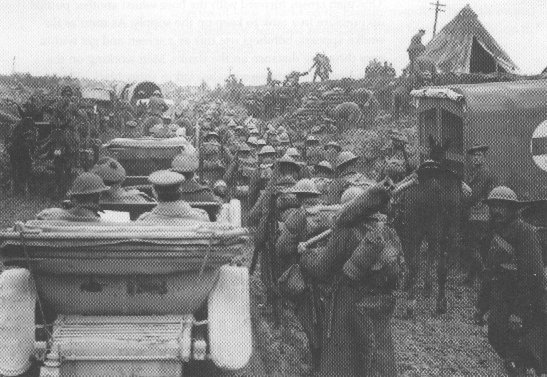 Battle of the Somme (13th October 1916): 5th Battalion, Royal Berkshire Regiment A crowded road at Fricourt. Staff-cars, mule-limbers, lorries, ambulance, infantry marching and pioneers road widening | |
| Saturday, October 14th | 61° - 50° overcast day. The French make progress. Rawlinson in his diary considers that the weather will bring the battle to a close soon. The glass is falling and the rain will shortly return. The roads will then become impassable and ammunition will not then be got to the guns. He says that casualties so far since July 1st are 40,000. |
| Sunday, October 15th | Rain 3mm. 57° - 41° rain in the morning, fine later. The British make progress in the neighbourhood of the Schwaben Redoubt and Thiepval. Rawlinson's diary entry is mainly taken up with a "plot" against Haig thought up by the Cabal. Rawlinson inspected the ground at Longueval and Delville Wood, as well as High Wood. At this time it seems to Rawlinson that the Germans are reviving themselves in the battle and fighting with greater tenacity. |
| Monday, October 16th | Rain-trace. 54° - 36°. There was to be a white frost from the 16th until the 20th of October. Bright sunny day, much colder. No operations. |
| Tuesday, October 17th | Rain 3mm. 55° - 43° fine day, rain at night. Haig confers with Rawlinson about future battle plans. |
| Wednesday, October 18th | Rain 4mm. 57° - 48° rain in the morning but cleared up later. The Battle of the Transloy Ridges ends. The British make progress north of Guedecourt and the French made progress, pushing the Germans out of Sailly. Rawlinson describes the progress during the day as partially successful. |
| Thursday, October 19th | Rain 4mm. 57° - 37° heavy rain during the day and especially in the morning. The Reserve Army operation was postponed for 48 hours. There was heavy rain the night before as well as in the morning of the 19th, and the roads and ground surface are in a dreadful state. |
| Friday, October 20th | 48° - 28° fine day but very, very cold. The lowest temperature so far recorded during the Battle of the Somme. Heavy German attacks against the Schwaben and Stuff Redoubts on the Thiepval Plateau repulsed. An Albatros German aircraft was brought down close to High Wood. Much flying and many photographs taken from the air. Very clear day for observation. |
| Saturday, October 21st | 45° - 28° fine but very cold day. The British advance on a line between the Schwaben Redoubt and le Sars and take many prisoners. A. J. Balfour visits Rawlinson and is anxious about the number of casualties and the supply of steel not being adequate. |
| Sunday, October 22nd | Temperature not known, fine bright day but bitterly cold. The French carry ridge to the west of Sailly. |
| Monday, October 23rd | Rain 3mm. 55° - 43° a dull misty morning. The British advance towards le Transloy and capture a thousand yards of enemy trenches. R. Dournie gained the VC to the east of Les boeufs. Kiggell and Gough have tea with Rawlinson and they agree to postpone the planned attack for the 25th to the 26th. |
| Tuesday, October 24th | Rain 3mm. 54° - 45° a dull day with rain. The French have success at Verdun in that they retake Douaumont and capture 3,500 prisoners. Trenchard has tea with Rawlinson and tells him that the enemy is producing a thousand aircraft a month, and that the RFC have lost 660 machines since July 1st. |
| Wednesday, October 25th | Rain 2mm. 52° - 45° rain in the morning which had made the area of Montauban. The shortage of supplies reduced the effectiveness of the artillery. |
| Thursday, October 26th | Rain 1mm. 55° - 39° a showery day particularly in the morning. Rawlinson postpones the operations due to take place today until the 30th. He then goes away for a short break to Versailles. He says that the weather is as bad as it can be. |
| Friday, October 27th | Rain 1mm. 55° - 43° showery and cold day. The conditions are so bad that Rawlinson considers that it would be a physical impossibility for the infantry to advance. Even moving across a short distance would wear the troops out. |
| Saturday, October 28th | Rain 8mm. 55° - 41° very wet and cold day. The German flying ace Oswald Boelcke was killed in a collision with one of his pilots. He was flying an Albatros D11 and had been credited with 40 "kills". |
| Sunday, October 29th | Rain 7mm. 53° - 45° another very wet day. Dewdrop and Hazy Trenches were taken in the morning by the Allies. |
| Monday, October 30th | Rain 7mm. 61° - 48° wet and dull cold day. There were deluges of rain which made the condition of the roads worse than ever. The French take trenches north-west of Sailly-Saillisel. |
| Tuesday, October 31st | 63° - 46°. The road and trench conditions are very bad indeed and the area around Guedecourt is waterlogged. Rawlinson despairs of a further advance. |
| Wednesday, November 1st | Rain 2mm. 59° - 46°. German counter-attack against Sailly-Saillisel repulsed. Allies advance north-east of Lesboeufs. Germans evacuate Fort Vaux at Verdun. |
| Thursday, November 2nd | Rain 3mm. 57° - 43°. The British capture trenches east of Guedecourt. |
| Friday, November 3rd | Rain 1mm. 59° - 48°. French advance to the outskirts of Vaux (Verdun). |
| Saturday, November 4th | Rain 2mm. 64° - 52° a wet and cloudy day. The French occupy Damlup (Verdun). Haig and Foch have conference with Rawlinson. |
| Sunday, November 5th | 59° - 48° clear day. The French occupy the whole of Vaux (Verdun). The British make some progress at the Butte de Warlencourt and towards le Transloy. The Anzac Corps gain and then lose Bayonet Trench. E. P. Bennett wins the VC at le Transloy. |
| Monday, November 6th | 57° - 45° a cloudy day. French progress near St. Pierre Vaast Wood. |
| Tuesday, November 7th | Rain 12mm. 55° - 45°. Then British progress to the east of the Butte de Warlencourt. |
| Wednesday, November 8th | Rain 2mm. 57° - 43°. The Germans repulsed at Saillisel. |
| Thursday, November 9th | 54° - 30° a bright and clear autumn day, frosty. Large aerial battle near Bapaume with 36 British and 40 Germans involved. Rawlinson says the British Gunners are complaining that too many German aircraft are now over Allied territory. |
| Friday, November 10th | 50° - 30°. The British capture the east portion of Regina Trench to the north of Thiepval. The French capture several German trenches to the northeast of Lesboeufs. Rawlinson tours part of the battlefield and visits Ginchy and Delville Wood. He wants to visit the Orchard at the southernmost corner of Ginchy but is deterred by the German 5.9's dropping into it. He sees for himself how appalling the roads are beyond Ginchy. |
| Saturday, November 11th | Rain-trace. 55° - 32° misty day with low cloud, also frosty. The British bombard the Germans on the Ancre. German aircraft bombed at night and caused casualties. |
| Sunday, November 12th | Rain-trace. 50° - 48° a dull overcast day. Henry Wilson visits Rawlinson. It is hoped that the big attack will take place on the next day. |
| Monday, November 13th | 54° - 46°. The Battle of the Ancre begins on a foggy morning and Beaumont Hamel is stormed by the British. They capture St. Pierre Divion, and Beaumont Hamel, and over 3,000 prisoners. The beginning of the fourth phase of the Battle of the Somme. J. Cunningham gains the VC opposite Hebuterne and B. C. Freyberg his at Beaucourt. Rawlinson describes the operations as being a great day for Gough and the Fifth Army. |
| Tuesday, November 14th | 55° - 36° overcast day. The British capture Beaucourt and advance to the east of the Butte de Warlencourt. The number of prisoners taken in the two days reaches 5,200. The north-east winds are drying winds. Haig visits Rawlinson on his way to Paris for a conference and is delighted at Gough's success. |
| Wednesday, November 15th | 46° - 37°. German counter-attacks fail. |
| Thursday, November 16th | 41° - 27° clear but cold day. The British extend their line eastwards from Beaucourt and retreat from part of the ground to the east of the Butte de Warlencourt. Rawlinson takes Lord Milner to Candas aerodrome and Trenchard shows them around. They also watch some flying arranged for them. |
| Friday, November 17th | Rain 2mm. 37° - 25° clear day. Further advances on the Ancre. |
| Saturday, November 18th | Rain 8mm. 54° - 36°. The British advance north and south of the Ancre and reach the outskirts of Grandcourt. The operations end and the Battle of the Somme is over. |
 |
 |
 |
 |
 |
| Click on any thumbnail to view the full size images | ||||
